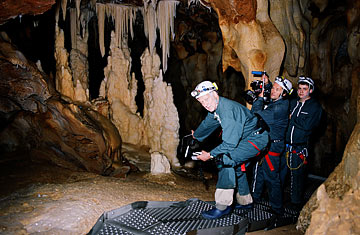
(2 of 2)
What we do know is that, among the hunters and spear-makers and pelt-curers of 30,000 B.C., there were artists. Someone far more sophisticated than the palm-print brigade sketched glorious images of wild animals — lions, wolves, bison, bears — many extinct, and all drawn with a sophistication that reveals their contours and propulsive power. The bison, for example, is shown with eight legs, "suggesting movement," Herzog says — "sort of a proto-cinema." The artist or artists also used the curves in the cave walls to give the figures a seductive illusion of depth, which justifies the director's use of 3-D. Most 3-D movies offer a carnival fun-house simulation of depth; things that come out at you. Here, things lure you in, allowing you to metaphorically run your fingers over the walls' surfaces, and to attempt a mind-reading of our most distant ancestors. "It is," the filmmaker grandly proclaims, "as if the modern human soul erupted here."
That's typical Herzog, a man out of his time, if not his mind. He is lured into myths of the ancient Teutonic stripe, to tales of human achievement in extreme cold, no less than Leni Riefenstahl, the great and compromised German actress-director of the 1930s. When she wasn't fashioning the landmark Nazi documentary Triumph of the Will, she was starring in mountain films (The White Hell of Pitz Palu, The Blue Light) and focusing her legend-making camera on the flying skiers in Olympia. Herzog's politics are not Riefenstahl's — he's an old-fashioned European leftie — but his documentary work has taken him into the high Alps, for the 1974 The Great Ecstasy of Woodcarver Steiner, a portrait of World Champion Sky-flyer Walter Steiner, and, in 2007, to Antarctica for Encounters at the End of the World, which finally won Herzog an Oscar nomination for Best Documentary Feature. And here he is, paying a call on fellow artists from the last glacial age.
He naturally wants to peer deep inside these unknown creators. "What do they dream?" he asks. "Do they cry at night?" And he finds other men with similar preoccupations. One is archaeologist Jean Clottes, who announces to the Chauvet visitors, "We are going to listen to the silence of the cave — maybe even hear our own heartbeats." Herzog the narrator, unable to keep quiet, whispers, "These images are memories of long-forgotten dreams. Are these their heartbeats, or ours?" Among his fellow travelers: a perfume specialist who sniffs the cave for olfactory revelations; and an architect (and former circus unicyclist) who, after five days in the caves, dreamed of lions and paintings of lions; and an "experimental archaeologist" who dresses in what he imagines was the couture of the day and, perhaps for the benefit of the History Channel's American audience, plays "The Star Spangled Banner" on his reconstruction of a Paleolithic flute.
An inspired teacher as well as a professional visionary, Herzog yokes the old age to ours. He sees the finest of the cave paintings as far superior to Picasso's work in his late "primitive" period; compares the suggestion of movement in the wall paintings to Fred Astaire's dancing with three large shadows of himself in the "Bojangles in Harlem" number from Swing Time; and invokes the babes of Baywatch when discussing the "Venus figurines" of women with prominent sexual organs. At the end, he invites us to see the paintings again, afresh and under stronger light, believing we can return to the images not as beginners but as connoisseurs. Then he adds a coda about a nearby nuclear plant that has stocked its warm pool with albino alligators (or possibly crocodiles; he's vague on that point). Proposing that the mutant reptiles may swim over to the cave, he asks, "Looking at the paintings — what will they make of them?"
But that's just Herzog being Herzog, with a spirit as outsize, outrageous and endearing as any of the subjects of his oneiric documentaries. At 68, he is as curious as ever, never ceasing in his lifelong journey to excavate the strangeness at the heart of the human soul. It wouldn't surprise me if he were to find his way to another cave, say in Pakistan, put its startled inhabitant in the frame of a 3-D camera and uttered the phrase, "Mr. bin Laden, I presume?"
MONDAY UPDATE: Now it would very much surprise me.
